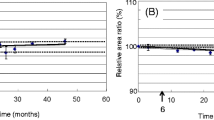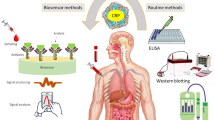Abstract
Radioimmunoassay (RIA) for C-reactive protein (CRP) is a clinical tool to quantify CRP, a cardiovascular diseases (CVDs) marker, in human serum. Development of the Radioimmunoassay includes radioiodination of CRP with 125I radioisotope, where radioiodination is conducted following the Chloramine-T method. The present study standardizes the radiolabeling procedure and key reagent concentrations like chloramine-T (oxidizing reagent), sodium metabisulfite, and potassium iodide. The outcome of the standardized radioiodination includes a reaction time of 60 s, iodination analytical parameters like % Radiochemical purity was ~ 97% with specific activity ~ 17 µCi/µg, and the tracer was stable for the 60 days. The optimized radioiodination method is simple, reproducible, and has high tracer stability with high immunoreactivity to develop an RIA procedure to quantify CRP in human serum.







Similar content being viewed by others
References
Tillett WS, Francis T (1930) Serological reactions in pneumonia with a non-protein somatic fraction of pneumococcus. J Exp Med 52(4):561–571
Volanakis JE (2001) Human C-reactive protein: expression, structure, and function. Mol Immunol 38(2–3):189–197
Pathak A, Agrawal A (2019) Evolution of C-reactive protein. Front Immunol 10(943):1–12
Mantovani A, Garlanda C, Doni A, Bottazzi B (2008) Pentraxins in innate immunity: from C-reactive protein to the long pentraxin PTX. J Clin Immunol 28(1):1–13
Ridker PM, Silvertown JD (2008) Inflammation, C-reactive protein, and atherothrombosis. J Periodontol 79(8):1544–1551
Hirschfield GM, Pepys MB (2003) C-reactive protein and cardiovascular disease: new insights from an old molecule. QJM Int J Med 96(11):793–807
Pepys MB, Hirschfield GM (2003) C-reactive protein: a critical update. J Clin Invest 111(12):1805–1812
Sproston NR, Ashworth JJ (2018) Role of C-reactive protein at sites of inflammation and infection. Front Immunol 9:754
Ridker PM, MacFadyen JG, Glynn RJ, Bradwin G, Hasan AA, Rifai N (2020) Comparison of interleukin-6, C-reactive protein, and low-density lipoprotein cholesterol as biomarkers of residual risk in contemporary practice: secondary analyses from the cardiovascular inflammation reduction trial. Eur Heart J 41(31):2952–61
Ridker PM (2016) From C-reactive protein to interleukin-6 to interleukin-1: moving upstream to identify novel targets for atheroprotection. Circ Res 118:145–156
Ridker PM (2018) Clinician’s guide to reducing inflammation to reduce atherothrombotic risk: JACC review topic of the week. J Am Coll Cardiol 72:3320–3331
Ellington AA, Kullo IJ, Bailey KR, Klee GG (2010) Antibody-based protein multiplex platforms: technical and operational challenges. Clin Chem 56(2):186–193
Borrebaeck CA (2000) Antibodies in diagnostics—from immunoassays to protein chips. Immunol 21:379–382
Yalow RS, Berson SA (1960) Immunoassay of endogenous plasma insulin in man. J Clin Investig 39(7):1157–1175
Youfeng H, Coenen HH, Petzold G, Stöcklin G (1982) A comparative study of radioiodination of simple aromatic compounds via N-halosuccinimides and chloramine-T in TFAA. J Label Compd Radiopharm 19(7):807–819
Bhalla HL, Vavia PR, Samuel G, Sivaprasad N (1997) Development of radioimmunoassay: I. Preparation of radiolabeled tracers theophylline. J Radioanal Nucl Chem 220:73–76
Hunter R (1970) Standardization of the chloramine-T method of protein iodination. Proc Soc Exp Biol Med 133(3):989–992
Bailey GS (2002) The chloramine T method for radiolabeling protein. The Protein Protocols Handbook. Springer Protocols Handbooks, Humana Press, pp 963–965
McConahey PJ, Dixon FJ (1966) A method of trace iodination of proteins for immunologic studies. Int Arch Allergy Immunol 29(2):185–189
Hunter WM, Greenwood F (1962) Preparation of iodine-131 labelled human growth hormone of high specific activity. Nature 194:495–496
Pimpalkhute M, Majali M, Mani R (1986) Radioimmunoassay of human follicle stimulating hormone/HFSH. J Radioanal Nucl Chem 103(2):105–116
Kaddar N, Bendridi N, Harthé C, de Ravel MR, Bienvenu AL, Cuilleron CY, Mappus E, Pugeat M, Déchaud H (2009) Development of a radioimmunoassay for the measurement of Bisphenol A in biological samples. Anal Chim Acta 645(1–2):1–4
Tai HH, Chey WY (1978) Development of radioimmunoassay for motilin. Anal Biochem 87(2):350–358
Tai HH, Yuan B (1978) Development of radioimmunoassay for thromboxane B2. Anal Biochem 87(2):343–349
Shine B, De Beer FC, Pepys MB (1981) Solid phase radioimmunoassays for human C-reactive protein. Clin Chim Acta 117(1):13–23
Rasmi RR, Shenoy KB, Kadwad VB, Sarnaik J, Somashekarappa HM (2015) Application of novel magnetizable cellulose particles in the development of immunoradiometric assay for C-peptide. J Radioanal Nucl Chem 304:1115–1122
Rasmi RR, Kadwad VB, Sarnaik J, Shenoy KB, Somashekarappa HM (2021) Development of radioimmunoassay for estimation of C-peptide in human serum. J Radioanal Nucl Chem 327:923–928
Manupriya BR, Paradkar S, Ghodke TS, Kadwad V, Karunakara N, Shenoy KB (2023) Development of a magnetizable cellulose particle-based immunoradiometric assay for quantification of C-peptide in rat serum. J Radioanal Nucl Chem 332(3):517–525
Greenwood FC, Hunter WM, Glover JS (1963) Radioiodination of proteins with chloramine T. Biochem J 89:114–123
Gnanasekar R, Sarnaik JS, Joseph NC, Kadwad VB, Mathur A (2021) Development of two-step radioimmunoassay (RIA) for the measurement of free triiodothyronine in human serum based on antibody coated tubes. J Radioanal Nucl Chem 329(1):71–76
Borque L, Bellod L, Rus A, Seco ML, Galisteo-Gonzalez F (2000) Development and validation of an automated and ultrasensitive immunoturbidimetric assay for C-reactive protein. Clin Chem 46(11):1839–1842
Bouzidi N, Messaoud MB, Maatouk F, Gamra H, Ferchichi S (2020) Relationship between high sensitivity C-reactive protein and angiographic severity of coronary artery disease. J Geriatr Cardiol 17(5):256–263
Wang W, Ren D, Wang CS, Li T, Yao HC (2019) High sensitivity C-reactive protein to prealbumin ratio measurement as a marker of the prognosis in acute coronary syndrome. Sci Rep 9(1):11583
Kaptoge S, Di Angelantonio E, Pennells L, Wood AM, White IR, Gao P, Walker M (2012) C-reactive protein, fibrinogen, and cardiovascular disease prediction. N Engl J Med 367(14):1310–1320
Acknowledgements
The authors are grateful to BRNS, DAE, Government of India for the financial support of this work. The authors are grateful for the continuous support from Rani Gnanasekar and Shripriya Purohit. The authors acknowledge the support of the Centre for Application of Radioisotopes & Radiation Technology (CARRT), Mangalore University, Department of Applied Zoology, Mangalore University, and the Board for Radiation and Isotope Technology (BRIT), Vashi Complex, Vashi, Mumbai.
Author information
Authors and Affiliations
Corresponding author
Ethics declarations
Conflict of interest
The authors declare that they have no conflict of interest.
Additional information
Publisher's Note
Springer Nature remains neutral with regard to jurisdictional claims in published maps and institutional affiliations.
Rights and permissions
Springer Nature or its licensor (e.g. a society or other partner) holds exclusive rights to this article under a publishing agreement with the author(s) or other rightsholder(s); author self-archiving of the accepted manuscript version of this article is solely governed by the terms of such publishing agreement and applicable law.
About this article
Cite this article
Ghodke, T.S., Manupriya, B.R., Kadwad, V. et al. 125I labelling of C-reactive protein for the development of Radioimmunoassay (RIA). J Radioanal Nucl Chem (2024). https://doi.org/10.1007/s10967-024-09425-6
Received:
Accepted:
Published:
DOI: https://doi.org/10.1007/s10967-024-09425-6




